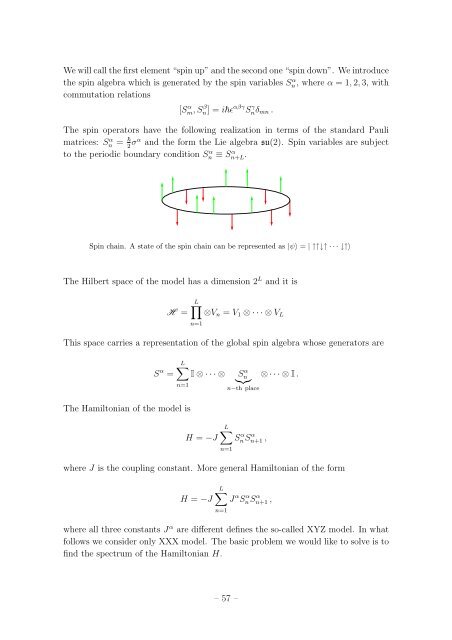Student Seminar: Classical and Quantum Integrable Systems
Student Seminar: Classical and Quantum Integrable Systems
Student Seminar: Classical and Quantum Integrable Systems
You also want an ePaper? Increase the reach of your titles
YUMPU automatically turns print PDFs into web optimized ePapers that Google loves.
We will call the first element “spin up” <strong>and</strong> the second one “spin down”. We introduce<br />
the spin algebra which is generated by the spin variables S α n, where α = 1, 2, 3, with<br />
commutation relations<br />
[S α m, S β n] = iɛ αβγ S γ nδ mn .<br />
The spin operators have the following realization in terms of the st<strong>and</strong>ard Pauli<br />
matrices: S α n = 2 σα <strong>and</strong> the form the Lie algebra su(2). Spin variables are subject<br />
to the periodic boundary condition S α n ≡ S α n+L .<br />
Spin chain. A state of the spin chain can be represented as |ψ〉 = | ↑↑↓↑ · · · ↓↑〉<br />
The Hilbert space of the model has a dimension 2 L <strong>and</strong> it is<br />
H =<br />
L∏<br />
⊗V n = V 1 ⊗ · · · ⊗ V L<br />
n=1<br />
This space carries a representation of the global spin algebra whose generators are<br />
S α =<br />
L∑<br />
I ⊗ · · · ⊗ Sn<br />
α }{{}<br />
⊗ · · · ⊗ I .<br />
n−th place<br />
n=1<br />
The Hamiltonian of the model is<br />
H = −J<br />
L∑<br />
SnS α n+1 α ,<br />
where J is the coupling constant. More general Hamiltonian of the form<br />
H = −J<br />
n=1<br />
L∑<br />
J α SnS α n+1 α ,<br />
n=1<br />
where all three constants J α are different defines the so-called XYZ model. In what<br />
follows we consider only XXX model. The basic problem we would like to solve is to<br />
find the spectrum of the Hamiltonian H.<br />
– 57 –

















